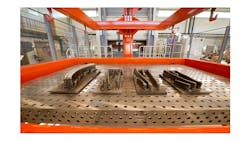Spirit AeroSystems Inc. and Norsk Titanium Components AS reported “a significant milestone” in their collaborative program to develop direct metal deposition (DMD) technology for manufacturing critical structural parts. According to the partners, they have achieved technology readiness level six (TRL6) in the project, meaning the process is able to match the standard requirements for aerospace materials.
"The aerospace industry is by far the largest and most demanding titanium segment in the world, and achieving TRL6 is a major milestone," stated Norsk Titanium CEO Jon Andre Lokke. "We are very pleased with the cooperation and support we have from Spirit and we are now eager to complete the qualification process and start producing parts for the aerospace industry."
Spirit AeroSystems designs and manufactures composite structural components for commercial aircraft at 10 locations in the U.S., England, France, Malaysia, and Scotland. Its products include forms for fuselages, pylons, nacelles, and wing components. It formed a partnership with Norsk Titanium to develop the latter’s DMD process to produce commercial aerospace parts in Ti6Al4V.
Norsk Titanium developed the laser-based DMD process, which produces titanium structures in “near net shape” form – rather than casting or forging shapes, or milling parts from billet stock. It’s a patented technology that uses plasma arc technology to melt titanium wire and depositing the molten material on a substrate, forming a part in near-net-shape according to a predetermined design.
The developer described DMD as the first process of its kind, capable of operating on a commercial scale to produce parts for industrial applications.
In the Spirit AeroSystems/Norsk Titanium partnership, DMD converts titanium wire into components that are 70- to 80-percent complete. According to the partners, standard milling technology for machining titanium may use only 10 percent of the raw material, and discard up to 90 percent.
In addition to reducing the amount of raw material used, the DMS process presents a faster route for design and production, greater design flexibility, and lower finishing costs overall.
"This is a significant achievement for the aerospace industry," stated Bill Smith, Spirit AeroSystems director of technology development. "Titanium is an expensive and difficult material to manufacture. By having near-net-shape product forms, Spirit is able to reduce costs. Additionally, this direct from digital process can reduce the time to market for new parts by at least 60 percent."
The qualification effort is expected to be completed next year, meaning a aircraft designers would be able to use DMD process to produce parts for new or current manufacturing programs.
About the Author
Robert Brooks
Content Director
Robert Brooks has been a business-to-business reporter, writer, editor, and columnist for more than 20 years, specializing in the primary metal and basic manufacturing industries.
